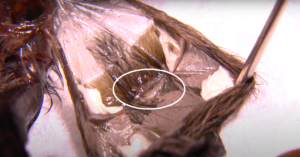
Most tarantulas look the same to the un-trained eye. But there are several differences and although the most reliable way of how to tell if a tarantula is male or female involves looking at the old exo-skeleton after a moult, there are a few subtle differences once they mature and reach adulthood.
Unfortunately, that answer doesn’t really help much, so we’re going to take a look at the differences between male and female tarantulas in more detail. Read on!
Size
As just mentioned, females tend to be larger than males. Smaller males are able to travel faster with their long legs.
Due to males being more active than females, they have a higher metabolic rate.
Males being smaller also tend to make them less of a target to predators when they’re out looking for a female to breed with.
There is another train of thought that females have gotten larger over time because they reproduce more abundantly.
Whatever the reason, sexual dimorphism in tarantulas has evolved over millions of years and works extremely well.
What is the Largest Female Tarantula?
The Goliath Birdeater (Theraphosa blondi) is the largest tarantula to be recorded. Females can reach a leg span of up to 12 inches and can weigh up to 175 g (6.2 oz). Females mature in roughly 3-6 years and have an average lifespan of 15 to 25 years.
Abdomen

Whilst not always the case, female tarantulas tend to have larger, rounder, abdomens than males. This is much easier to spot without a side-by-side comparison. Obviously, females are the ones storing the eggs and are less active than males, hence their “booty” being quite plump.
Pedipalps
Mature male tarantulas have larger pedipalps. The reason for this is that once they mature, they fill their pedipalps with sperm before going to seek out a female.
They use these charged palps by inserting them into the female’s genital opening and hoping that they don’t get eaten in the process.
Exoskeleton
The best way of determining whether your tarantula is male or female, is of course examining the exoskeleton after a moult. This is able to be done from as early as their fourth moult although after their sixth moult is preferable.
Any earlier than the sixth and you will likely have to use a stereoscopic microscope. Any earlier than the fourth and they are not mature enough to have the correct anatomical parts that you’re looking for.
You will have to be very careful when doing this, as the part you will be examining is extremely delicate and could break and crumble in your hands. Once you have very gently opened the “tail end” of the molt, you will be able to see the genetalia inside.


The things to look out for when sexing a tarantula are the “flap” and the spermathecae (they look like rabbit ears). If they are both present, then your tarantula is 100% a female. If they are lacking, then your tarantula is a male.
We hope this has cleared this question up for you, it’s not easy telling the difference between a male and a female tarantula, but using our guide, hopefully you’ll feel slightly more educated!
